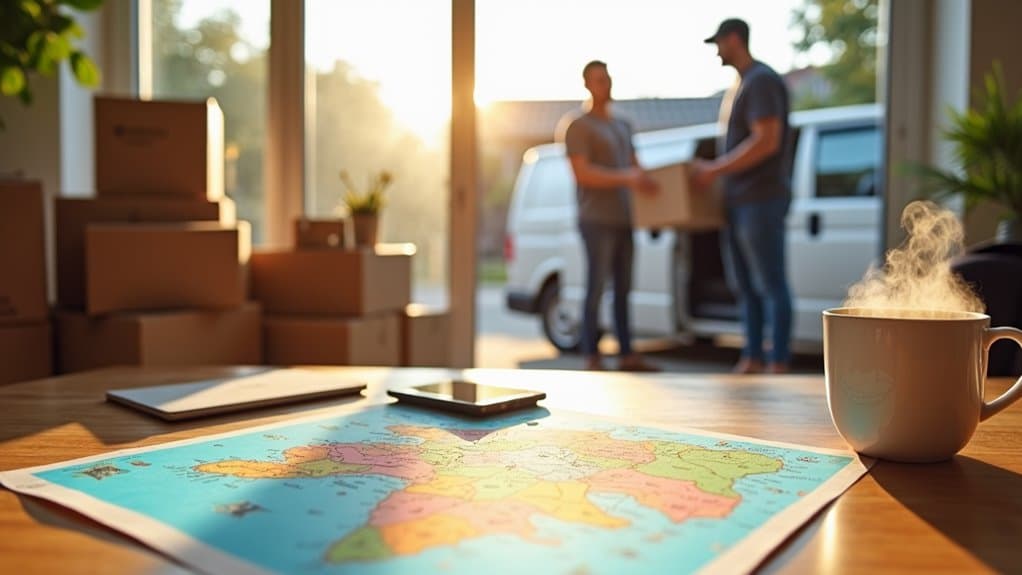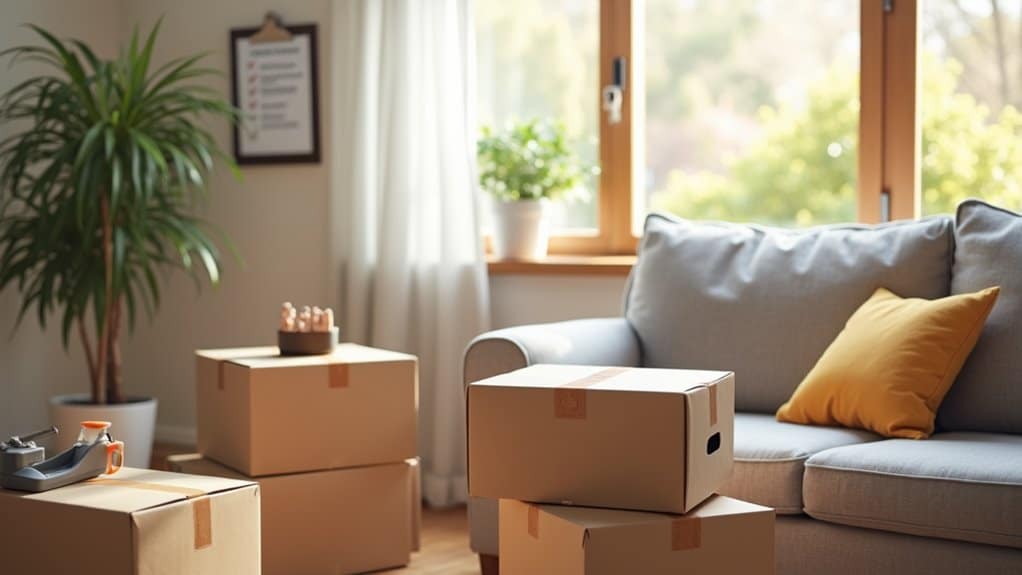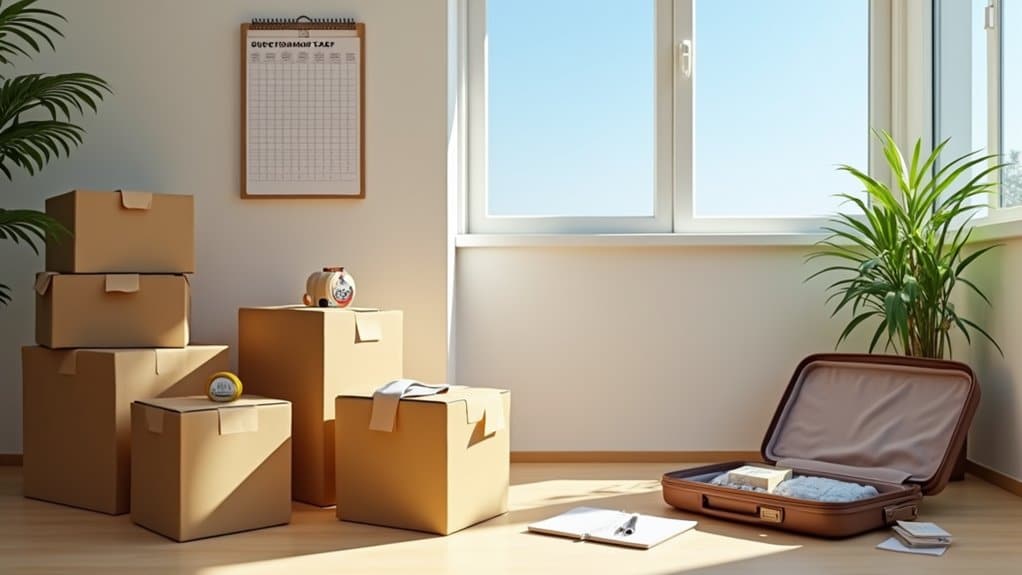
How to Plan a Smooth House Move Within Your City
To plan a smooth house move within your city, start by setting a budget and researching reliable moving companies. Obtain quotes and select one that offers a fixed price to avoid unexpected costs. Begin decluttering at least a month in advance, sorting items into 'keep', 'donate', and 'discard' piles. Collect packing materials early and pack methodically, ensuring each box is clearly labelled. On moving day, start early, confirm arrangements with your movers, and keep essential items accessible. Lastly, remember to clean your old home for the next occupants. Following these steps will help ensure a successful move.
Key Takeaways
- Set a clear budget that considers potential issues like stairs and parking restrictions during your move.
- Compare several removal firms to find a reliable service that provides a fixed quote, helping you avoid any surprise costs.
- Start decluttering at least a month in advance by sorting your belongings into four categories: keep, donate, sell, and throw away.
- Collect packing materials early and adopt a systematic packing approach, labelling boxes clearly for a smoother unpacking process.
- Create a checklist for your final preparations, making sure all utilities are arranged and the old property is clean for the new occupants.
Pre-Move Planning Essentials
When preparing for a house move, effective planning is key to ensuring a smooth transition. Start with your budget. Figure out how much you can afford for the move, considering factors like stairs, narrow hallways, and parking issues. Additionally, it's wise to research removal companies early on to find a trustworthy service that fits your needs.
Also, think about your family's needs, including the care of children, pets, and elderly relatives. If you need to transport vehicles, include those costs as well.
Next, organise your documentation. Create a moving binder to keep everything in one place. Start with a room-by-room inventory, noting down items to be moved and measuring any large furniture. Additionally, it's important to evaluate complexity by assessing challenges that may complicate the move.
Check your moving insurance to ensure your belongings are covered during transit. Gather all relevant paperwork and keep it in your binder.
Finally, compare quotes from various moving services, whether you're hiring professionals or renting a van. This straightforward approach will help you stick to your budget and make the logistics of your move easier.
With these essentials sorted, you'll be well on your way to a successful relocation.
Effective Organizing and Decluttering
To ensure a smooth move, begin your decluttering at least a month in advance. Tackle one room at a time to determine what you genuinely need and what can be discarded. Remember to obtain your packing materials early, so you can organise your belongings effectively. For instance, consider sorting through your wardrobe; if you haven't worn something in over a year, it might be time to let it go. By decluttering, you can reduce moving costs and make the transition to your new home much easier. Additionally, selling unwanted items can provide extra cash that can be helpful during your move.
Start Early Decluttering
Starting early with decluttering is crucial for a smooth house move, as it helps ensure an organised transition. Aim to begin your decluttering process at least six weeks before your move. This timeframe allows you to reap the benefits of decluttering, such as reduced stress and lower moving costs. Use effective sorting methods to categorise your items into keep, donate, sell, or discard. Additionally, consider using strong cardboard boxes for packing items you decide to keep, as they provide better protection during transport.
Here's a simple table to visualise your sorting process:
| Category | Action |
|---|---|
| Keep | Pack for the move |
| Donate | Arrange a collection |
| Sell | List online or hold a car boot sale |
| Discard | Throw away or recycle |
Start with areas that contain lesser-used items, like seasonal decorations or books. Consider creating a "maybe" pile for items you're uncertain about, giving you the chance to reassess later. By starting early and being systematic in your decluttering, you'll make your move easier and enjoy a fresh start in your new home. Remember, the less you have to move, the smoother the process will be! Additionally, scheduling regular decluttering sessions can help maintain focus and motivation throughout the process.
Room-by-Room Inventory
Organising a house move can be daunting, but creating a room-by-room inventory simplifies the process. Here are some straightforward steps to help you stay organised and ensure nothing is forgotten:
- Create a room-by-room checklist: Sort your belongings by each room.
- List significant items: Include furniture, appliances, and any important possessions.
- Document details: Record the original price, purchase year, and model or serial number of each item. This is essential for accurate insurance claims in case of loss or damage.
Using digital tools like spreadsheets or apps can make documenting and tracking items easier. As you go through each room, take photos or videos of key items for visual reference.
Declutter by sorting items into four categories: keep, donate, sell, or throw away.
After organising, pack room by room, clearly labelling boxes with their contents and destination rooms. Consider colour-coding or tagging systems for added efficiency.
Secure Packing Materials
Choosing the right packing materials is crucial for a smooth move, ensuring your belongings reach your new home safely.
Start with sturdy cardboard boxes in various sizes to accommodate different items. For fragile items, use bubble wrap or packing paper to provide cushioning and protection. Fill any gaps in boxes with extra packing materials to stop items from shifting during transit. Utilizing quality packing tape will help ensure that your boxes remain secure throughout the moving process.
For larger items like furniture, wrap them in moving blankets for added protection. Secure all boxes with packing tape to keep them closed and intact throughout the move.
Gather your packing supplies in advance to stay organised. As you pack, label each box clearly with its contents and the room they belong in, making unpacking much easier.
Consider reusing household items, such as thick blankets, to save on packing materials. By focusing on the right materials and packing methods, you'll make the moving process more efficient and keep your belongings safe.
Smart Packing Strategies

Packing efficiently can significantly reduce the stress of moving. Here are some smart packing strategies to consider:
- Start early and declutter your belongings.
- Label boxes for easy organisation.
- Protect fragile items with bubble wrap.
Begin by planning your packing. Focus on one room at a time, ideally starting with those you use the least. Pack items you rarely use first, leaving essentials for last.
For boxing, use smaller boxes for heavy items and larger ones for lighter items to optimise space.
Utilise household items to your advantage. Suitcases are perfect for clothes and towels, and rolling your clothes can save space. Liquor boxes with dividers are excellent for shoes, while large pots can hold small kitchen gadgets.
As you pack, label each box with its contents and the room it belongs to. Consider colour coding your labels for quicker identification.
This systematic approach will make unpacking easier, helping your new home feel organised from day one. By following these packing strategies, you can ensure a smoother move.
Logistical Arrangements for Moving
When planning your move, effective logistical arrangements are crucial for a smooth transition. Start by creating a moving timeline to prioritise tasks and break them down into manageable deadlines.
Begin decluttering and sorting your belongings six weeks in advance, and gather packing materials four weeks before the move.
Next, coordinate with your removal company. Confirm start times, addresses, and any special instructions they may require, particularly if you're in a flat that needs moving permits.
Choose a company that offers a fixed quote to avoid unexpected charges, and ensure they're aware of any lift access requirements. Keep communication open with your movers to address any concerns or changes.
As moving day nears, check that both properties are ready—lay down protective coverings and arrange for utilities to be set up.
Clearly label boxes and give your movers instructions on where to place them. Unpack essential items first to make settling in easier.
Lastly, be prepared for potential delays; having a backup plan will help reduce stress. With thorough logistical planning, your move can be efficient and hassle-free.
Final Preparations Before Moving Day

Before moving day, it's essential to take apart large furniture to simplify transport and minimise any potential damage.
Remember to give your old home a good clean to ensure it's in decent shape for the next occupants.
These final preparations will help ensure a smooth transition to your new home.
Disassemble Large Furniture
Disassembling large furniture is crucial for a hassle-free moving day, ensuring that each piece can fit through narrow doorways and tight hallways without damage. Here are some key tips for disassembling furniture:
- Measure everything: Know the dimensions of your furniture and doorways to plan effectively.
- Protect fragile items: Use bubble wrap and blankets to safeguard mirrors and glass.
- Organise systematically: Label each disassembled part for easy reassembly.
Start by cleaning and emptying your furniture to prevent damage during the process.
Gather the necessary tools like screwdrivers and wrenches, then carefully remove movable items like drawers and cushions.
Unscrew doors and pack them carefully, and don't forget to take off furniture legs to make transport easier.
As you disassemble, label each part and store screws and bolts in labelled bags to avoid confusion later.
Double-check that your measurements align with your moving vehicle and doorway sizes.
Final Home Cleaning
As moving day approaches, a thorough final clean of your home is essential for a smooth transition. Start by creating a checklist to ensure you cover every corner.
In the kitchen, focus on deep cleaning: scrub the fridge, wipe down the cupboards, and disinfect the dishwasher. Remember to sweep and mop the floors.
Next, tackle the bedrooms. Dust all surfaces, clean out wardrobes, and use glass cleaner on mirrors and windows. Vacuum carpets and hard floors to remove any lingering dust.
For the bathrooms, start with stubborn stains in the shower and toilet. Use grout cleaner on tiles, disinfect all surfaces, and organise drawers and cabinets for a fresh start.
Finally, in the common areas and living spaces, dust all surfaces and wipe down tables. Clean the windows and sills, then sweep, vacuum, or mop the floors.
Moving Day Best Practices
Moving day can be hectic, so staying organised and prepared is vital for a smooth transition. A moving day checklist can help ensure you don't overlook any important tasks. Here are some best practices to keep in mind:
- Get up early and have a substantial breakfast to keep your energy levels up.
- Set aside personal essentials like medication and important documents for quick access.
- Coordinate with the movers to confirm start times and any special instructions.
Before the moving truck arrives, ensure everything is packed and labelled. Use sturdy packing materials to protect your belongings, and tackle one room at a time.
Don't forget to prepare a "first night box" with essentials like toiletries and a change of clothes.
Throughout the day, keep snacks, drinks, and a basic first aid kit on hand for any minor mishaps.
Protect the floors and walls of both homes to prevent damage.
Frequently Asked Questions
How Do I Choose Between DIY and Hiring Professional Movers?
To decide between DIY and hiring professional movers, consider the costs versus the time involved. If budget is a priority, doing it yourself might be the way to go. For instance, packing up your belongings and enlisting friends can save you money. However, if you prefer to save time and minimise stress, hiring professionals could be worth the investment. They handle everything from packing to heavy lifting, allowing you to focus on settling into your new home.
What Should I Do With Items I Can't Take With Me?
When you can't take items with you, think about donating them to local charities or shelters. For items you're uncertain about, consider using temporary storage until you decide what to do with them or find them a new home.
How Can I Keep My Pets Calm During the Move?
Moving can be quite stressful for your pets. To help keep them calm, create a quiet space in your home where they can feel safe. Bring along familiar toys and bedding to provide comfort. Additionally, consider using pet-friendly techniques like calming sprays or music designed for pets. These simple steps can make the transition to your new home much smoother for your furry friends.
What's the Best Way to Handle Fragile Items?
To handle fragile items, use effective packing techniques with protective materials such as bubble wrap and sturdy boxes. Wrap each item separately, fill any gaps to prevent movement, and clearly label the boxes. This ensures safe transport and helps minimise damage. For example, when packing glassware, wrap each piece in bubble wrap and use a strong box, filling any empty spaces with packing peanuts or crumpled paper.
How Do I Ensure My Utilities Are Set up on Moving Day?
To ensure your utilities are ready on moving day, arrange for transfers well in advance. Contact your providers to confirm activation dates and check everything is in order before you arrive. For instance, ensure your electricity and water are switched on, so you're not left in the dark or without running water. By taking these steps, you'll have a smooth start in your new home.
Conclusion
Planning your move carefully can turn a chaotic experience into a smooth one. While packing can seem daunting, think about the joy of your new home and the memories you'll create there. By organising your belongings in advance, you can clear the clutter and make the transition easier. Each step—whether it's decluttering or finalising arrangements—brings you closer to settling into your new space. Embrace the process, and before you know it, you'll be enjoying the comfort of your new home.


